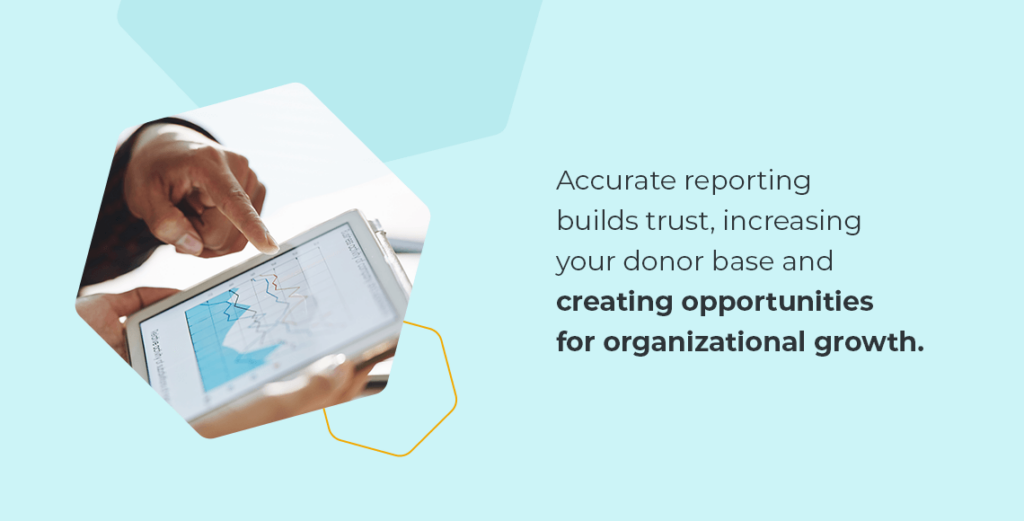Nonprofits rely on donations to keep their operations running. However, nonprofit donations often vary from month to month and year to year. To manage your nonprofit’s finances strategically, you need a donation management system.
Donation management includes steps like tracking donations, completing financial reports and communicating with donors. Learn more about donation management and five practices you can implement for a stronger management plan.
What Is Donation Management?
Your nonprofit can track all donations through a management system. The system you use depends on the size of your organization and what works best for you. Although smaller nonprofits have fewer donations to track, they can still benefit from an organized system.
Here are a few components of managing nonprofit donations:
- A donor communication plan
- A policy for receiving donations
- Familiarity with your donor base
- A software management system
- Understanding compliance requirements
Although there can be many components to donation management, the purpose of each remains the same — to track all donations so you can accurately report how they’ve been used to support your nonprofit.
Accurate reporting builds trust, increasing your donor base and creating opportunities for organizational growth. It also ensures that you meet all compliance requirements for how donations are used.

Finally, managing nonprofit donations equips you to strategically budget and ensure all expenses are covered for the next period. Keeping your finances organized empowers you to make in-the-moment decisions about how much you can invest in organizational growth.
Types of Nonprofit Donors
At a nonprofit, you’ll receive donations from several different kinds of donors. Categorizing your donors can help you create a communication plan so you follow up with past donors at the right time. While some donors give once, others may contribute to your nonprofit on a regular schedule.
Here are several common types of donors:
- Individual donors
- Corporate donors
- Foundation donations
- One-time fundraising donations
- Government grants
While some donations come from individuals, others come from groups or organizations that care about your nonprofit’s mission. Understanding the intent behind each donation can help you appropriately respond, thanking the donors and recording details about their transactions for the future.
Different Types of Donations
To manage donations responsibly, your nonprofit organization needs to track all donations, regardless of their type and form. However, because donations can vary so much, keeping track of them can be challenging.
Here are several common types of nonprofit donations:
- Cash donations
- In-kind donations
- Appreciated donations
Cash donations include all strictly financial donations. For example, checks, physical cash and monetary donations that come through your website or an app are all considered cash donations.
By contrast, in-kind donations are either goods or services donated to your organization. Examples of in-kind donations could include new computers, furniture or office supplies. In-kind service donations might include free tax services or volunteer hours.
Although appreciated donations are technically a form of cash donation, they deserve their own category. Examples of appreciated donations include items like stocks, bonds and mutual funds that may go up in value after donation. Your organization may also sell them for cash. This kind of donation is less common for nonprofits.
While some nonprofit donations are unrestricted, others are specified as restricted. Restricted donations can legally only be used as the donors have requested. When planning your nonprofit’s annual budget, it’s a good idea to start with restricted donations to ensure every aspect of your operation is funded.
What Donation Data to Track
Data is the foundation you use to build a sound financial strategy for your nonprofit. The more information you track, the more you’ll have to work with in the future. There are several categories of data to track as a nonprofit:
- Donor information: This includes contact information, past donations and other personal details.
- Donation details: Record the date, donation amount, type, timing, and whether the funds are restricted or unrestricted.
- Communication tracking: Track when you send communications, the type of communication and any donor feedback.
When in doubt, record more information than you think you’ll need. You can always delete or ignore excess information in the future. However, it’s much harder to remember details when you’re working with many donors over time.
Details about past donations ensure your financial records are accurate. However, they also give you a larger picture of who supports your nonprofit, why they care and where you can look for future donations. The more data you gather, the more information you’ll have to base your future decisions on.
5 Tips for Intentional Donor Management
Because managing donation and donor information includes so many details, it can seem overwhelming. Here are five tips to help you create an effective donor and donation management plan.
- Create a donor database: Keep track of all your organization’s donors. Include the donor’s contact information and the frequency and size of their donations. This is also an excellent place to record how often you communicate with each donor.
- Use a donation management system: Using reliable software can help keep your financial records accessible and organized. A software system makes it easier to keep track of donation data and share it with donors and stakeholders.
- Create a communication plan: Use feedback to decide what donor communication should look like. Plan how often you should reach out and what you’ll say. How can you stay connected and provide value to your donors?
- Automate management tasks: Modern software systems often include automation features, saving you a significant amount of time. You can automate communication and records to stay on top of donations.
- Prepare for audits: Audits ensure your nonprofit is meeting regulatory compliance. The more organized your daily operations are, the better prepared you’ll be for audits, regardless of when and how often they occur.
Another tip is to make sure your staff understands the donation management systems you have in place. Consider putting up charts showing the flow of donation management so employees and volunteers always know the next step and their responsibilities.
Request a Software Demo With MIP Fund Accounting
If you’re looking for the perfect nonprofit accounting software, look no further. At MIP Fund Accounting, we have over 30 years of experience serving nonprofits, government entities and K-12 schools. Our accounting software is designed to help you easily track and manage donation data.
Because our software is cloud-based, it provides additional backup in case your digital devices are ever damaged or lost. Our software is scalable, so you won’t need to find a new partner when your organization grows. When you partner with us, you can improve your data tracking and the financial health of your nonprofit organization.
Contact us today to request a free software demo!
Share this post





